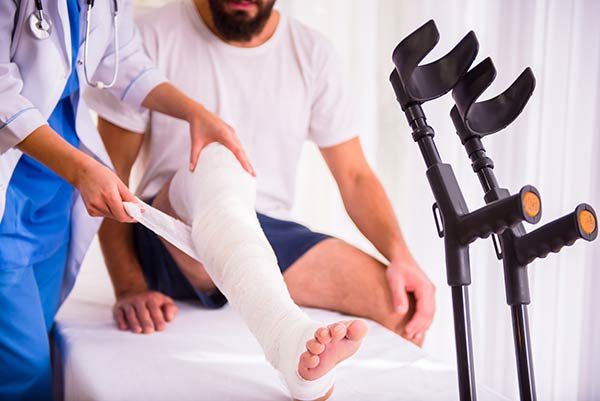
What is short-term disability? And what kind of coverage can you buy to protect yourself if you experience one? You might be surprised at what you already have available. We’ll go over the possibilities and explain how owning your own disability insurance can protect your most valuable asset – your ability to earn a paycheck.
➡️ Protect your paycheck with a disability insurance plan! Call us at (800) 823-4852 to learn more, or click the button below to request a free quote.
Request a Free QuoteJump to a section:
What Is a Short-Term Disability?
Option #1: Workers’ Compensation
Option #2: State-Mandated Short-Term Disability Coverage
Option #3: Short-Term Disability Coverage through Work
Option #4: Own Your Own Short-Term Disability Policy
What Is a Short-Term Disability?
A short-term disability happens when you get sick or hurt and can’t work for anywhere between a few weeks and a few months. It happens to more people than you might think – over 1 in 4 of 20-year olds today will experience a disability before they retire!*
Now, imagine if something like that happened to you. How would your family pay the bills if you couldn’t work for, say, four months? Not only do you have your regular expenses (rent, mortgage, food, utilities, car payment, etc.), but you probably also have insurance co-pays, prescription co-pays, and hospital bills, too.
Most of us underestimate how long it takes to recover from relatively common accidents and injuries. For example, it can take up to 2 months to heal a simple fracture. And a broken rib? You might be unable to resume regular activity for 6-8 weeks. Depending on your job, those time frames could present a major issue in terms of resuming or continuing your employment. Common causes of short-term disability claims include:
- COVID-19
- Cancer treatment
- Pregnancy or maternity leave
- Digestive disorders
- Respiratory illnesses, including pneumonia
- Assorted injuries from sports, car accidents, etc.
- Recovery from surgery
- Mental health issues

Keep in mind that the federal government’s disability programs, Social Security Disability Insurance (SSDI) and Supplemental Security Income (SSI), are only available if your disability is expected to last longer than 12 months. In other words, it doesn’t cover short-term disabilities at all.
The best solution? Understand what insurance options are available so you can keep providing for your family no matter what. Below, we’ll take a look at the types of coverage and compensation available.
➡️ Protect your paycheck with a disability insurance plan! Call us at (800) 823-4852 to learn more, or click the button below to request a free quote.
Request a Free QuoteOption #1: Workers’ Compensation
Workers’ Comp is a form of insurance employers carry to pay the medical expenses for any workers who are injured on the job. Employers pay 100% of these premiums – workers do not have to pay anything to be eligible for payment if they’re injured. Keep in mind that you’re only eligible for Workers’ Comp if you are injured on the job site or in the course of performing your work duties.
The goal of a workers’ comp policy is to cover the employee’s medical expenses, replace lost wages, and help the employee get back to work as soon as possible. That includes paying for rehabilitation, or training the employee to take another position if they can no longer perform the duties of their previous position.

But, as you may have guessed, most injuries don’t actually happen at work. In fact, according to the NSC, a whopping 95% of deaths and 86% of medically consulted injuries in 2021 happened off the job. In fact, six times as many injuries happen off the job as on the job.** So for most people, workers’ comp is not an option.
➡️ Protect your paycheck with a disability insurance plan! Call us at (800) 823-4852 to learn more, or click the button below to request a free quote.
Request a Free QuoteOption #2: State-Mandated Short-Term Disability Coverage

Some states (and one territory) require employers to provide short-term disability insurance (SDI). You may also see this referred to as temporary disability insurance (TDI). As of 2023, these include:
- California
- Hawaii
- New Jersey
- New York
- Rhode Island
- Puerto Rico
Each state has its own qualification rules, including the work history requirements (hours worked or dollars earned per year or week). If you experience a qualifying disability in one of these states, you would file a claim with the relevant state office. If you also have your own private short-term policy, you can still apply for those benefits, too. The state-mandated coverage may adjust the amount you’re paid as a result.
➡️ Protect your paycheck with a disability insurance plan! Call us at (800) 823-4852 to learn more, or click the button below to request a free quote.
Request a Free QuoteOption #3: Short-Term Disability Coverage through Work
About 40% of U.S. workers have access to short-term coverage through their employers.*** You may even be automatically enrolled for coverage as part of your benefits package. If you’re not sure, ask your HR rep.

Some employer-sponsored coverage is 100% paid by the employer, while other programs can either split the cost between the employer and the employee, or ask the employee to pay the entire cost. As with private insurance (option #4, below), these policies pay out a specific percentage of your pre-disability income, anywhere from 40% - 70%.
Most plans start paying out one week after the date the claim was filed. Depending on your employer’s choice of plan to offer, you can receive benefits for anywhere from a couple months all the way up to a full year. Anything keeping you out of work for over one year would be classified as a long-term disability, and handled differently.
➡️ Protect your paycheck with a disability insurance plan! Call us at (800) 823-4852 to learn more, or click the button below to request a free quote.
Request a Free QuoteOption #4: Own Your Own Short-Term Disability Policy
You can also buy your own short-term disability coverage, which helps ensure you’re never at risk even if you change jobs, go freelance, or work in the gig economy. When you own your coverage, you make the payments (not your employer).

Private coverage is designed to replace about 60% of your pre-disability income – in other words, a significant portion of your after-tax pay. Every insurer will set their own guidelines in terms of waiting periods and covered conditions. But since we’re talking short-term conditions, the waiting periods are usually brief, from 1-2 weeks after your qualifying injury or illness.
To get your claim approved, you’ll need to be under a doctor’s care and have their sign-off that your disability will indeed keep you out of work for the minimum amount of time required by the policy, often 7 consecutive days or 1 calendar month.
In most cases, your claim will be processed within 2 weeks (often faster). The insurer will review your claim, and may consult with your doctor and your employer to verify the fact that you are unable to work. Once they’ve approved your claim, you are eligible to collect benefits for the duration of your benefit period or until you’re able to go back to work. If you also have a long-term disability plan, the short-term plan’s benefits can tide you over until your long-term coverage kicks in.
➡️ Protect your paycheck with a disability insurance plan! Call us at (800) 823-4852 to learn more, or click the button below to request a free quote.
Request a Free Quote*Social Security Basic Facts, SSA.gov. Accessed 9/19/23.
**National Safety Council, InjuryFacts.NSC.org. Accessed 9/19/23.
***As of 2022, National Bureau of Economic Research. Accessed 9/19/23.
